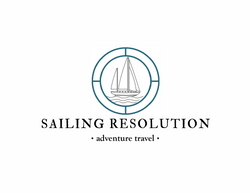Equipment / Prevention / Routines
Safety and prevention are of utmost importance and will be taught and practiced as soon as you board the boat. All crew sailing with us will be required to sign a second waiver after their safety briefing to acknowledge that they have received the training.
Prevention is most important. The boat is thoroughly inspected before each trip to make sure all major systems and rigging are in safe and proper working order. The captain does regular engine room checks when using the engine.
Accidents can happen easily underway while trying to maneuver on a moving vessel. Resolution has something to grab or brace yourself with all throughout the interior of the boat. Always having a minimum of three points of contact with the boat at all times will help prevent injuries. Accidents are especially common in the head and galley and injury prevention will be discussed.
There is a propane sniffer with an alarm installed below the oven. A high water alarm is also installed in the bilge. There are 3 smoke/carbon monoxide detectors onboard (see locations on diagram below).
All thru hulls on the boat have a corresponding bung tied to the seacock for emergencies.
The boat is equipped with an AIS transceiver, radar, VHF radio, Iridium GO exec for weather routing and emergency satellite phone, EPIRB, Commercial Vessel Distress Signal Kit, a Garmin InReach, there is a MOB1 AIS transmitter in each Mustang Survival HIT inflatable PFD that will be provided for all crew to use while on board (and trained on how to set off if it doesn’t automatically activate). The captain and mate each have a PLB.
Fires-
The boat is equipped with 4 Type B1 Fire Extinguishers and a Fire Blanket. See diagram below for their locations.
Man Overboard (MOB)-
The prevention of a MOB scenario is the primary focus. If someone goes overboard in rough seas the chances of surviving and getting back on board are not always good. While we will teach you the protocol for a man overboard scenario, the main focus is how NOT to fall off the boat.
Prevention includes keeping center of gravity low when moving forward of the cockpit and always having at least three points of contact with the boat. Never lean over the lifelines. Having sound physical fitness and good balance help prevent you from falling and possibly going over the lifelines. If you must go forward, always walk on the high side of the boat. Preventers will be used to prevent accidental jibes from knocking people overboard. Jacklines along both sides of the boat and padeyes in the cockpit will be used at night and in heavy weather with double tethers (one short and one long) attached to the provided Mustang Survival HIT Inflatable PFD to safely move around on deck while always being connected to the boat.
Abandon Ship-
If there is ever a serious enough emergency to require abandoning the ship, the captain will make the call and alert the crew. Each crew member on board will have a role that will be assigned to them. All crew will be trained on how to make a Mayday call on the radio and how to activate the McMurdo SmartFind G8 Cat 1 EPIRB (SmartFind G8).
The boat is equipped with a ditch bag that contains emergency equipment, first aid, and food and water for all crew on board. It will be someone’s role to grab this and take it into the liferaft.
Daily Safety-
PFD checks - see green on canister
PFDs worn on deck
Jacklines/tethers used to go forward of cockpit at night and in heavy weather -
not without captain or mate’s permission and supervision
Sit watch in pairs, and usually with either captain or mate
First aid kit on board
Proper use of winch is taught
Air horn used in limited visibility. Explain how each type of vessel is to sound it
Teach the use of proper navigation lights on our vessel and other vessels
Proper propane use with stove is taught
Proper toilet use to prevent water from filling the bowl and overflowing
How to use the VHF radio
Preventers are used on boom whenever sailing downwind, regardless of sea
state or weather conditions


